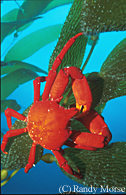Time: 5-10 class periods depending on group size and technical skills of students.
Materials/Resources:
- Kelp Organism List
- Kelp Organism PowerPoint Criteria worksheet
- Kelp Organism PowerPoint Resource notesheet
- Kelp Organism PowerPoint Source Info worksheet
- Kelp Organism PowerPoint Bibliography reference sheet
- Kelp Organism PowerPoint Rubric worksheet
- Individual or small group computer access
- Microsoft PowerPoint software on each computer
- Classroom LCD Projector (optional)
- Construction paper
- Colored markers/pencils
Internet Resources:
Format:
PowerPoint in the Classroom tutorial site #1
PowerPoint in the Classroom tutorial site #2
APA Style
MLA Style
Information:
Birch Aquarium Voyager Giant Kelp site
Channel Islands National Marine Sanctuary Encyclopedia of the Sanctuaries kelp site
Golden State Images site
Inchinapinch Kelp Forest site
MBARI Giant Kelp site
Monterey Aquarium All About Kelp site
SiMON Kelp Forests Overview site
Vocabulary:
ecology
interdependent
Procedure:
- Cut out Kelp Organism slips. Put in an envelope or lay upside down on table and have students select one. Distribute Kelp Organism PowerPoint Criteria worksheet and Kelp Organism PowerPoint Resource worksheet. Discuss expectations for the assignment and show example work. The PowerPoint Tutorial (#1 or #2) can be done individually or as a class, depending on need.
- Students begin research via books or internet and record basic information on Kelp Organism PowerPoint Resource notesheet as well as record resource information on Kelp Organism PowerPoint Source Info worksheet. In their PowerPoint presentation, students will want to adhear to standard bibliographic criteria, especially regarding electronic sources. Refer them to the basic Kelp Organism PowerPoint Bibliography format sheet.
- Students begin creating PowerPoint presentation. Fear not if you are a PowerPoint novice; with the most rudimentary guidance (e.g. new slide function, toolbars), students easily explore the program and make use of its capabilities. Be sure to review with students the types of presentation design/effects that draw in viewers as opposed to distract from the message (e.g. special effects, sound, quality of text and pictures).
- Discuss effective presentation skills. Have students present their projects to the class. Have other students assess colleagues’ work using the Kelp Organism PowerPoint Rubric worksheet in addition to teacher evaluation. Examples of student kelp organism PowerPoint projects.
- Students create paper models of their kelp forest organism. On a 3x5 card on the reverse of the model, have students note the organism's common name, scientific name, classification categories (Kingdom, Phylum, Class, Order, Family), energy source, reproduction, and niche within the kelp forest (producer, predator, grazer, etc.), and any other useful/interesting information. Attach the models in an appropriate location on the 3-D classroom kelp forest.
Homework:
The PowerPoint project may be worked on at home if the student has access to the appropriate technology. Favorite websites can once again be explored at home and shared the following day. Models and/or description cards can be assigned as homework.
Assessment:
See Unit Homepage
